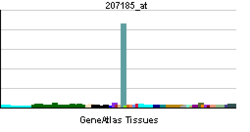- SLC10A1
-
Solute carrier family 10 (sodium/bile acid cotransporter family), member 1 Identifiers Symbols SLC10A1; LBAT; NTCP; NTCP1 External IDs OMIM: 182396 MGI: 97379 HomoloGene: 31126 GeneCards: SLC10A1 Gene Gene Ontology Molecular function • bile acid:sodium symporter activity
• symporter activityCellular component • membrane fraction
• plasma membrane
• integral to plasma membrane
• basolateral plasma membraneBiological process • transport
• ion transport
• sodium ion transport
• bile acid metabolic process
• organic anion transport
• bile acid and bile salt transportSources: Amigo / QuickGO RNA expression pattern 
More reference expression data Orthologs Species Human Mouse Entrez 6554 20493 Ensembl ENSG00000100652 ENSMUSG00000021135 UniProt Q14973 O35940 RefSeq (mRNA) NM_003049 NM_011387 RefSeq (protein) NP_003040 NP_035517 Location (UCSC) Chr 14:
70.24 – 70.26 MbChr 12:
82.05 – 82.07 MbPubMed search [1] [2] Sodium/bile acid cotransporter also known as the Na+-taurocholate cotransporting polypeptide (NTCP) or liver bile acid transporter (LBAT) is a protein that in humans is encoded by the SLC10A1 (solute carrier family 10 member 1) gene.[1][2]
Contents
Function
Sodium/bile acid cotransporters are integral membrane glycoproteins that participate in the enterohepatic circulation of bile acids. Two homologous transporters are involved in the reabsorption of bile acids, one absorbing from the intestinal lumen, the bile duct, and the kidney with an apical localization (SLC10A2), and the other being found in the basolateral membranes of hepatocytes (SLC10A1; this protein).[1]
See also
References
- ^ a b "Entrez Gene: SLC10A1 solute carrier family 10 (sodium/bile acid cotransporter family), member 1". http://www.ncbi.nlm.nih.gov/sites/entrez?Db=gene&Cmd=ShowDetailView&TermToSearch=6554.
- ^ Hagenbuch B, Meier PJ (March 1994). "Molecular cloning, chromosomal localization, and functional characterization of a human liver Na+/bile acid cotransporter". J. Clin. Invest. 93 (3): 1326–31. doi:10.1172/JCI117091. PMC 294097. PMID 8132774. http://www.pubmedcentral.nih.gov/articlerender.fcgi?tool=pmcentrez&artid=294097.
Further reading
- Trauner M, Boyer JL (2003). "Bile salt transporters: molecular characterization, function, and regulation". Physiol. Rev. 83 (2): 633–71. doi:10.1152/physrev.00027.2002. PMID 12663868.
- Shiao T, Iwahashi M, Fortune J et al. (2001). "Structural and functional characterization of liver cell-specific activity of the human sodium/taurocholate cotransporter". Genomics 69 (2): 203–13. doi:10.1006/geno.2000.6329. PMID 11031103.
- Müller O, Schalla C, Scheibner J et al. (2002). "Expression of liver plasma membrane transporters in gallstone-susceptible and gallstone-resistant mice". Biochem. J. 361 (Pt 3): 673–9. doi:10.1042/0264-6021:3610673. PMC 1222351. PMID 11802798. http://www.pubmedcentral.nih.gov/articlerender.fcgi?tool=pmcentrez&artid=1222351.
- Hallén S, Mareninova O, Brändén M, Sachs G (2002). "Organization of the membrane domain of the human liver sodium/bile acid cotransporter". Biochemistry 41 (23): 7253–66. doi:10.1021/bi012152s. PMID 12044156.
- Strausberg RL, Feingold EA, Grouse LH et al. (2003). "Generation and initial analysis of more than 15,000 full-length human and mouse cDNA sequences". Proc. Natl. Acad. Sci. U.S.A. 99 (26): 16899–903. doi:10.1073/pnas.242603899. PMC 139241. PMID 12477932. http://www.pubmedcentral.nih.gov/articlerender.fcgi?tool=pmcentrez&artid=139241.
- Ho RH, Leake BF, Roberts RL et al. (2004). "Ethnicity-dependent polymorphism in Na+-taurocholate cotransporting polypeptide (SLC10A1) reveals a domain critical for bile acid substrate recognition". J. Biol. Chem. 279 (8): 7213–22. doi:10.1074/jbc.M305782200. PMID 14660639.
- Jung D, Hagenbuch B, Fried M et al. (2004). "Role of liver-enriched transcription factors and nuclear receptors in regulating the human, mouse, and rat NTCP gene". Am. J. Physiol. Gastrointest. Liver Physiol. 286 (5): G752–61. doi:10.1152/ajpgi.00456.2003. PMID 14701722.
- Gerhard DS, Wagner L, Feingold EA et al. (2004). "The status, quality, and expansion of the NIH full-length cDNA project: the Mammalian Gene Collection (MGC)". Genome Res. 14 (10B): 2121–7. doi:10.1101/gr.2596504. PMC 528928. PMID 15489334. http://www.pubmedcentral.nih.gov/articlerender.fcgi?tool=pmcentrez&artid=528928.
- Alrefai WA, Sarwar Z, Tyagi S et al. (2005). "Cholesterol modulates human intestinal sodium-dependent bile acid transporter". Am. J. Physiol. Gastrointest. Liver Physiol. 288 (5): G978–85. doi:10.1152/ajpgi.00379.2004. PMID 15604201.
- Chen HL, Chen HL, Liu YJ et al. (2005). "Developmental expression of canalicular transporter genes in human liver". J. Hepatol. 43 (3): 472–7. doi:10.1016/j.jhep.2005.02.030. PMID 15922475.
- Anwer MS, Gillin H, Mukhopadhyay S et al. (2005). "Dephosphorylation of Ser-226 facilitates plasma membrane retention of Ntcp". J. Biol. Chem. 280 (39): 33687–92. doi:10.1074/jbc.M502151200. PMID 16027164.
- Eloranta JJ, Jung D, Kullak-Ublick GA (2006). "The human Na+-taurocholate cotransporting polypeptide gene is activated by glucocorticoid receptor and peroxisome proliferator-activated receptor-gamma coactivator-1alpha, and suppressed by bile acids via a small heterodimer partner-dependent mechanism". Mol. Endocrinol. 20 (1): 65–79. doi:10.1210/me.2005-0159. PMID 16123152.
- Dias V, Ribeiro V (2007). "The expression of the solute carriers NTCP and OCT-1 is regulated by cholesterol in HepG2 cells". Fundamental & clinical pharmacology 21 (4): 445–50. doi:10.1111/j.1472-8206.2007.00517.x. PMID 17635184.
SLC11–20 - (12) electroneutral cation-Cl cotransporter (SLC12A1, SLC12A1, SLC12A2, SLC12A3, SLC12A4, SLC12A5, SLC12A6, SLC12A7, SLC12A8, SLC12A9)
- (14) urea transporter (SLC14A1, SLC14A2)
- (15) proton oligopeptide cotransporter (SLC15A1, SLC15A2, SLC15A3, SLC15A4)
- (16) monocarboxylate transporter (SLC16A1, SLC16A2, SLC16A3, SLC16A4, SLC16A5, SLC16A6, SLC16A7, SLC16A8, SLC16A9, SLC16A10, SLC16A11, SLC16A12, SLC16A13, SLC16A14)
SLC21–30 - (21) organic anion transporting (SLCO1A2, SLCO1B1, SLCO1B3, SLCO1B4, SLCO1C1) (SLCO2A1, SLCO2B1) (SLCO3A1) (SLCO4A1, SLCO4C1) (SLCO5A1) (SLCO6A1)
- (22) organic cation/anion/zwitterion transporter (SLC22A1, SLC22A2, SLC22A3, SLC22A4, SLC22A5, SLC22A6, SLC22A7, SLC22A8, SLC22A9, SLC22A10, SLC22A11, SLC22A12, SLC22A13, SLC22A14, SLC22A15, SLC22A16, SLC22A17, SLC22A18, SLC22A19, SLC22A20)
- (24) Na+/(Ca2+-K+) exchanger (SLC24A1, SLC24A2, SLC24A3, SLC24A4, SLC24A5, SLC24A6)
- (25) mitochondrial carrier (SLC25A1, SLC25A2, SLC25A3, SLC25A4, SLC25A5, SLC25A6, SLC25A7, SLC25A8, SLC25A9, SLC25A10, SLC25A11, SLC25A12, SLC25A13, SLC25A14, SLC25A15, SLC25A16, SLC25A17, SLC25A18, SLC25A19, SLC25A20, SLC25A21, SLC25A22, SLC25A23, SLC25A24, SLC25A25, SLC25A26, SLC25A27, SLC25A28, SLC25A29, SLC25A30, SLC25A31, SLC25A32, SLC25A33, SLC25A34, SLC25A35, SLC25A36, SLC25A37, SLC25A38, SLC25A39, SLC25A40, SLC25A41, SLC25A42, SLC25A43, SLC25A44, SLC25A45, SLC25A46)
SLC31–40 - (32) vesicular inhibitory amino-acid transporter (SLC32A1)
- (33) Acetyl-CoA transporter (SLC33A1)
- (35) nucleoside-sugar transporter (SLC35A1, SLC35A2, SLC35A3, SLC35A4, SLC35A5) (SLC35B1, SLC35B2, SLC35B3, SLC35B4) (SLC35C1, SLC35C2) (SLC35D1, SLC35D2, SLC35D3) (SLC35E1, SLC35E2, SLC35E3, SLC35E4)
- (36) proton-coupled amino-acid transporter (SLC36A1, SLC36A2, SLC36A3, SLC36A4)36A2 ·
- (37) sugar-phosphate/phosphate exchanger (SLC37A1, SLC37A2, SLC37A3, SLC37A4)
- (38) System A & N, sodium-coupled neutral amino-acid transporter (SLC38A1, SLC38A2, SLC38A3, SLC38A4, SLC38A5, SLC38A6, SLC38A10)
- (39) metal ion transporter (SLC39A1, SLC39A2, SLC39A3, SLC39A4, SLC39A5, SLC39A6, SLC39A7, SLC39A8, SLC39A9, SLC39A10, SLC39A11, SLC39A12, SLC39A13, SLC39A14)
- (40) basolateral iron transporter (SLC40A1)
SLC41–48 SLCO1–4 Ion pumps Categories:- Human proteins
- Membrane protein stubs
- Solute carrier family
Wikimedia Foundation. 2010.
